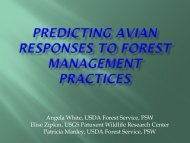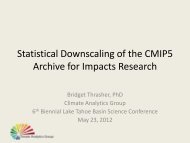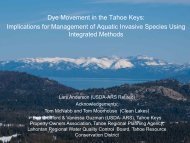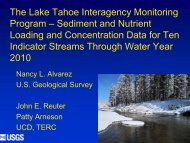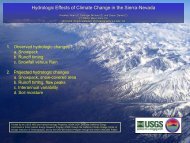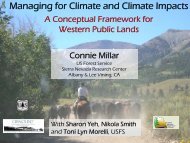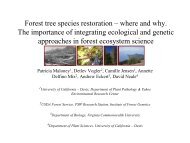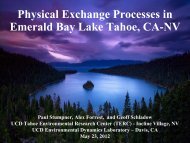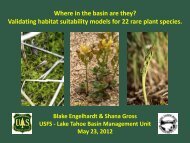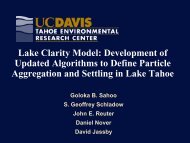Sutherland, Roger C
Sutherland, Roger C
Sutherland, Roger C
Create successful ePaper yourself
Turn your PDF publications into a flip-book with our unique Google optimized e-Paper software.
A Demonstration of SIMPTM’s<br />
Ability to Predict Fine Sediment<br />
Discharges from Existing<br />
Urbanized Landscapes Tributary<br />
to Lake Tahoe<br />
Presented at:<br />
Presented by:<br />
2012 Tahoe Science Conference<br />
May 23, 2012<br />
Sierra Nevada College<br />
Incline Village, NV<br />
<strong>Roger</strong> C. <strong>Sutherland</strong>, PE<br />
AMEC Environmental and Infrastructure, Inc<br />
7376 SW Durham Road<br />
Portland, OR 97224<br />
503-639-3400<br />
roger.sutherland@amec.com<br />
1
2<br />
Pollutant Load Reduction Model (PLRM)<br />
The primary purpose of the PLRM is to assist project designers to select<br />
and justify a recommended storm water project alternative based on a<br />
quantitative comparison of pollutant loads and runoff volumes for<br />
project alternatives. Pollutant loads in stormwater are highly variable, and<br />
notoriously difficult to predict with absolute accuracy at particular locations<br />
and times. The focus of the PLRM is to make use of best available Lake<br />
Tahoe storm water quality information to compare relative performance of<br />
alternatives over the long term.<br />
Clearly, the PLRM should be as accurate as possible in the<br />
simulation of the various processes that result in the<br />
contamination of stormwater and the BMP related interactions<br />
that can result in the reduction of that contamination.
3<br />
Pollutant Load Reduction Model (PLRM)<br />
The three elements used for simulating<br />
pollutant loads in the PLRM are:<br />
1) hydrology and hydrologic source<br />
controls (HSC),<br />
2) pollutant load generation and<br />
pollutant source controls (PSC), and<br />
3) storm water treatment (SWT).<br />
User input is required for each element, and the results derived from each element are<br />
used in subsequent elements. Computed pollutant loads represent the combined<br />
effectiveness of the three major elements.<br />
This presentation will focus on the pollutant load generation and pollutant source<br />
control component since that is the component that many users believe needs the<br />
most improvement
4<br />
Pollutant Load Reduction Model (PLRM)<br />
Pollutant generation in the PLRM is based on the product of average annual<br />
runoff and land use based characteristic runoff concentration (CRC).<br />
Two separate methods are used to represent the implementation of Pollutant<br />
Generation and Pollutant Source Control (PSCs) that can reduce the CRC’s:<br />
Road Methodology –a standardized approach for public right of ways<br />
that integrates physiographic characteristics, pollutant source control<br />
efforts, and pollutant recovery to predict the likely road condition and<br />
associated CRCs<br />
Parcel Methodology - a simple method to estimate improvements in<br />
CRCs from private property BMP implementation consistent with<br />
current regulations
5<br />
PLRM Uses a Simple Method for Load Estimates<br />
Many models like the PLRM simplistically generate estimates of TSS or other<br />
pollutant loadings by multiplying an computed runoff volume by an assumed TSS<br />
or pollutant concentration (i.e. CRC in the PLRM). This is referred to as the Simple<br />
Method (SM). The representative concentration is either an average or a medium<br />
concentration observed for a given land use and remains invariable from storm to<br />
storm which is the case in the PLRM. More advanced SM approaches assume a<br />
distribution of concentrations in an attempt to add the appearance of variability and<br />
uncertainty.<br />
Problems with the Simple Method approach are:<br />
• Cannot estimate actual storm-by-storm pollutant loadings, concentrations<br />
and sediment particle size distributions (PSD’s) transported by the runoff.<br />
• Cannot accurately estimate pollutant reduction benefits of various BMPs<br />
especially non structural practices such as street and catchbasin cleaning.<br />
• Loads will always mimic any errors or bias in the stormwater data itself<br />
which have been shown to be quite extensive on many occasions.
6<br />
PLRM Cannot Accurately Compute Fine Sediment<br />
Concentrations or Particle Counts<br />
The PLRM can not directly compute the particle size distribution (PSD) of<br />
the sediments being transported by runoff nor the number of particles<br />
within certain specified size groups like the fine sediment fraction of less<br />
than 16 micron fraction.<br />
Accurate estimates of the TSS mass loadings and the number of fine<br />
sediment particles in stormwater entering the Lake is important information<br />
needed for TMDL implementation planning and the Lake Clarity Model<br />
(LCM).<br />
Accurate estimates of the reduction in the TSS mass loadings and the<br />
number of fine particles entering the Lake as a result of implementing<br />
specific stormwater management practices is essential to achieving<br />
compliance with the TMDLs<br />
AMEC’s Simplified Particulate Model (SIMPTM) offers the solution
7<br />
Simplified Particulate Transport Model (SIMPTM)<br />
SIMPTM explicitly simulates over a extended time frame:<br />
The physical processes that relate to the accumulation of<br />
contaminated sediments on impervious urban surfaces and their<br />
association to other pollutants like nutrients, metals and toxics.<br />
The physical processes that relate to the washoff of<br />
accumulated contaminated sediments by shallow upland<br />
overland and/or gutter flow (i.e. based on proven sediment<br />
transport equations).<br />
The physical processes that relate to the ability of a specified<br />
street cleaning operation to periodically pick up and remove<br />
variable amounts of accumulated contaminated sediments within<br />
pre determined particle size ranges.
8<br />
Simplified Particulate Transport Model (SIMPTM)<br />
This results in accurate estimates of:<br />
Event by event sediment loadings, concentrations and<br />
particle size distributions (including particles counts) from<br />
urban watersheds with user specified physical<br />
characteristics such as slope, and effective imperviousness<br />
over a historic rainfall record of unlimited length<br />
Accumulated contaminated sediment loadings (i.e. street<br />
dirt) including particle size distribution and associated<br />
pollutants using user specified potencies or dry weight<br />
concentrations by particle size range.<br />
Contaminated sediment and associated pollutant pick up<br />
or removal from simulated user specified street cleaning or<br />
catchbasin cleaning operations.
9<br />
Accumulation Functions Available in EPA’s<br />
StormWater Management Model (SWMM)<br />
The exponential accumulation equation (i.e. equation 3) predominately<br />
used in the water quality component of SWMM is assumed to approach<br />
a maximum allowable value thought by many to vary by land use
10<br />
SWMM’s Exponential Accumulation Equation<br />
Cannot Explain Observed Behaviors<br />
SWMM’s exponential accumulation equation cannot explain high accumulations<br />
found at relatively short accumulation time periods like those observed in the<br />
1981 Bellevue NURP data for Surrey Down single family residential site
Accumulation (lbs/paved acre)<br />
Washoff Load (lbs/paved acre)<br />
11<br />
Exponential Accumulation Provides Poor Results<br />
Simulated washoff values using SWMM’s exponential accumulation equation<br />
are higher during dry seasons and lower during the wet season than observed<br />
as shown using the City of Portland Phase I NPDES data for site C1<br />
60<br />
50<br />
Observed<br />
Simulated<br />
7<br />
6<br />
40<br />
30<br />
20<br />
5<br />
4<br />
3<br />
2<br />
10<br />
DRY<br />
WET<br />
DRY<br />
WET<br />
0<br />
0<br />
Mar-91 Jun-91 Sep-91 Dec-91 Apr-92 Jul-92 Oct-92 Jan-93<br />
1
Accumulation / Equilibrium (E)<br />
12<br />
Accumulation Algorithm used by SIMPTM<br />
The previously defined maximum value is actually an equilibrium value. In<br />
a process referred to as wet weather washon sediments from adjacent<br />
impervious areas are deposited by overland flow onto streets and parking<br />
lots. This occurs somewhat infrequently and is driven by storm intensity<br />
with an intensity of 0.5 inches per hour or more that appears to trigger it.<br />
Accumulation Time
13<br />
SIMPTM’s Unique Accumulation Algorithm<br />
SIMPTM’s unique accumulation algorithm can explain high accumulations<br />
at relatively short accumulation periods like those observed in 1980-81<br />
Bellevue NURP data for Surrey Downs single-family residential site
Accumulation (lbs/paved acre)<br />
14<br />
SIMPTMs Algorithms Have Proven They Work<br />
Dashed line is the accumulation results from the exponential accumulation<br />
equation shown previously and the solid line is SIMPTMs results with its<br />
unique accumulation function. Notice that SIMPTM accumulations are<br />
reduced during the dry seasons and increased during the wet season<br />
50<br />
45<br />
DRY<br />
WET<br />
DRY<br />
40<br />
35<br />
30<br />
25<br />
20<br />
15<br />
10<br />
Mar-91 Jun-91 Sep-91 Dec-91 Mar-92 Jun-92
TSS Washoff Load (kg)<br />
15<br />
SIMPTMs Algorithms Have Proven They Work<br />
There is a direct relationship between accumulation and washoff and as a<br />
result of SIMPTM’s unique accumulation and sediment transport based<br />
washoff algorithms the model has been proven to work<br />
5<br />
4<br />
Observed<br />
Simulated<br />
3<br />
2<br />
1<br />
0<br />
Mar-91 Jun-91 Sep-91 Dec-91 Apr-92 Jul-92 Oct-92<br />
Jan-93<br />
Site C-1 City of Portland NPDES Phase I data
Removal by Sweeper in Size Range (J)<br />
Street Cleaning Algorithm Used by SIMPTM<br />
Street Cleaner Sediment Pick Up by Particle Size Group (J)<br />
0.7<br />
0.6<br />
P(J)<br />
SSmin(J) = The base residual loading<br />
particulate size range (J)<br />
0.5<br />
0.4<br />
0.3<br />
SSeff(J) = The street cleaning<br />
effectiveness as a fraction of the<br />
particulate loadings in excess of the base<br />
residual for size range (J)<br />
1<br />
SSeff(J)<br />
0.2<br />
0.1<br />
L(J)<br />
0.0<br />
0.0 0.1 0.2 0.3 0.4 0.5 0.6 0.7 0.8 0.9 10.0<br />
SSmin(J)<br />
Initial Accumulation in Size Range (J)<br />
User specified SSeffs and SSmins for each particle size group<br />
describes the pick up characteristics of specific street cleaning<br />
model. Obtained from sweeper pick up performance testing.<br />
16
After (lbs/curb mile)<br />
17<br />
Street Sweeping Function Used by SIMPTM<br />
Pick-up Performance<br />
SIMPTM’s Algorithms Have Proven They Work<br />
Tandem street sweeping data collected in Portland, OR<br />
30<br />
Size Group #1<br />
30<br />
SIM Tandem<br />
OBS Tandem<br />
18<br />
SIMPTM’s Algorithms Have Proven They Work<br />
SIMPTM Calibration<br />
Street Accumulation (kg/curb km)<br />
Observed<br />
70<br />
Model (match pt)<br />
60<br />
Model<br />
50<br />
40<br />
30<br />
20<br />
10<br />
0<br />
3/15/00 5/4/00 6/23/00 8/12/00 10/1/00 11/20/00<br />
Calibration Date<br />
Durand Single Family Residential Site<br />
City of Jackson Michigan Street Sweeping Study
19<br />
SIMPTM’s Algorithms Have Proven They Work<br />
Calibration Results for Ross Ade<br />
Storm of Nov 1, 1972<br />
from Ellis & <strong>Sutherland</strong>, 1979<br />
Calibration Results for Livonia Drain<br />
Storm of 29 June 1977
20<br />
Why Do the Algorithms in SIMPTM Matter Now?<br />
The Tahoe Basin needs a reliable methodology that can provide user’s with an<br />
accurate estimate of TSS concentrations, particle counts for fine sediment and the<br />
concentration of other associated pollutants that are expected to be realized once a<br />
specific set of actions or BMP’s are implemented including an exciting new<br />
technology called Captive Hydrology.<br />
More knowledge can be gained from<br />
an analysis of the extensive 2003-2004<br />
TMDL data base that contains a total of<br />
254 sampled storm events that<br />
occurred on eight different relatively<br />
small urban watersheds that encircle<br />
the Lake (i.e. ~32 events per<br />
watershed). The sampled storms only<br />
represent ~50% of the events that<br />
actually occurred during the study<br />
period and an explicit modeling<br />
approach allows us to predict the<br />
quality of those unsampled storms.<br />
Site Name<br />
Speedboat<br />
SLT-Y<br />
TCWTS<br />
Osgood Ave.<br />
Coon St.<br />
Mountain Dr.<br />
Sequoia<br />
B and Bonanza<br />
ID<br />
SB<br />
SY<br />
S1<br />
O3<br />
CI<br />
MD<br />
SQ<br />
BB
Runoff Volume (cm 3 )<br />
Precipitation (cm)<br />
21<br />
Example of TMDL 2003-2004 Storm Data Base<br />
3,500<br />
3,000<br />
2,500<br />
2,000<br />
Event Snowmelt<br />
Postevent Snowmelt<br />
Rain<br />
Rain on Snow<br />
Thunderstorm<br />
Precipitation<br />
10<br />
8<br />
6<br />
1,500<br />
1,000<br />
500<br />
0<br />
Oct-02 Jan-03 Apr-03 Jul-03 Nov-03 Feb-04 May-04 Aug-04<br />
4<br />
2<br />
0<br />
Time series of sampled runoff events at SY and precipitation<br />
measured at South Lake Tahoe Airport, CA (Arneson 2009)<br />
Figure taken from Matthew Zelin’s 2011 UC Davis Master of Science Thesis on the<br />
“Characterization Of Fine Sediment In Urban Runoff In Lake Tahoe, California-Nevada”
Captive Hydrology Cleaner Tel Aviv Israel Jan 2002<br />
22
23<br />
Captive Hydrology – Will It Work in the Tahoe Basin?<br />
Has existed for many years in Great Britain, Netherlands, Germany and Israel<br />
Used to retexture or clean both traditional and porous pavements<br />
Can extend pavement life by 3 to 5 years which will save highway departments<br />
money<br />
Removes pollutants accumulated on the surface and embedded in the<br />
pavement matrix which should provide huge stormwater quality benefits<br />
especially as it relates to fine sediment discharges.<br />
Can attack the primary source of stormwater pollution which is “street dirt”<br />
Can operate in winter conditions<br />
Should provide the most cost effective pollutant reduction that can be achieved<br />
Will pick up 100% of the fine sediment it can access – the perfect street cleaner!<br />
Captive Hydrology needs to be carefully evaluated before a<br />
decision is made to acquire one of these machines since the<br />
acquisition cost will be close to $1 million
24<br />
So AMEC’s Proposal is to Add the Tested and<br />
Proven SIMPTM Algorithms to the PLRM<br />
SIMPTM cannot currently handle the complicated rain on snow and snowmelt<br />
hydrology that occurs throughout the Tahoe Basin. As a result a direct demonstration<br />
of its unique simulation cababilities could not be provided as originally intended.<br />
So assuming that the continuous event by event hydrologic response of these urban<br />
Lake Tahoe watersheds has already been sufficiently dealt with in the Hydrologic<br />
Simulation Element of the PLRM then SIMPTM’s algorithms for accumulation,<br />
washoff, removal by cleaning practices and other pollutant associations should be<br />
added to the PLRM.<br />
The Clarity Of Lake Tahoe Depends On It
25<br />
QUESTIONS????<br />
Subwatershed<br />
Urban Area



